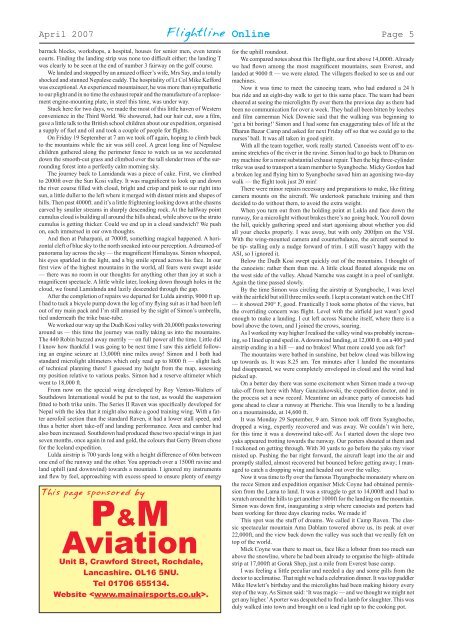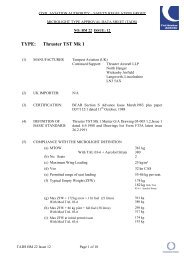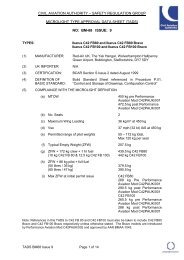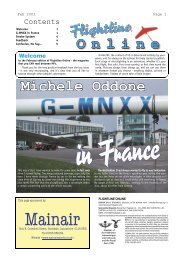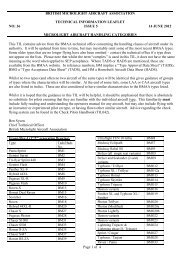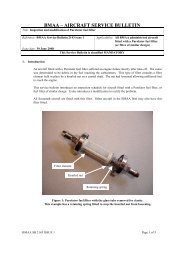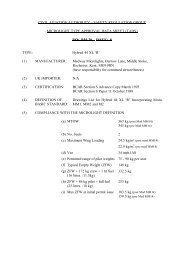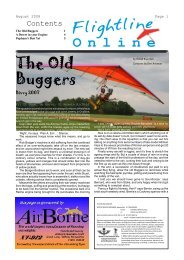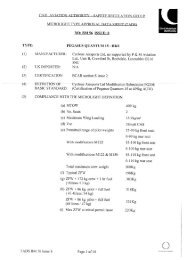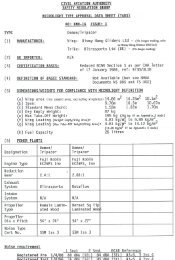Gambian Buchaneer By Andy Buchan - British Microlight Aircraft ...
Gambian Buchaneer By Andy Buchan - British Microlight Aircraft ...
Gambian Buchaneer By Andy Buchan - British Microlight Aircraft ...
You also want an ePaper? Increase the reach of your titles
YUMPU automatically turns print PDFs into web optimized ePapers that Google loves.
April 2007 Flightline Online Page 5<br />
barrack blocks, workshops, a hospital, houses for senior men, even tennis<br />
courts. Finding the landing strip was none too difficult either; the landing T<br />
was clearly to be seen at the end of number 3 fairway on the golf course.<br />
We landed and stopped by an amazed officer’s wife, Mrs Say, and a totally<br />
shocked and stunned Nepalese caddy. The hospitality of Lt Col Mike Kefford<br />
was exceptional. An experienced mountaineer, he was more than sympathetic<br />
to our plight and in no time the exhaust repair and the manufacture of a replacement<br />
engine-mounting plate, in steel this time, was under way.<br />
Stuck here for two days, we made the most of this little haven of Western<br />
convenience in the Third World. We showered, had our hair cut, saw a film,<br />
gave a little talk to the <strong>British</strong> school children about our expedition, organised<br />
a supply of fuel and oil and took a couple of people for flights.<br />
On Friday 19 September at 7 am we took off again, hoping to climb back<br />
to the mountains while the air was still cool. A great long line of Nepalese<br />
children gathered along the perimeter fence to watch us as we accelerated<br />
down the smooth-cut grass and climbed over the tall slender trees of the surrounding<br />
forest into a perfectly calm morning sky.<br />
The journey back to Lamidanda was a piece of cake. First, we climbed<br />
to 2000ft over the Sun Kosi valley. It was magnificent to look up and down<br />
the river course filled with cloud, bright and crisp and pink to our right into<br />
sun, a little duller to the left where it merged with distant mists and shapes of<br />
hills. Then past 4000ft. and it’s a little frightening looking down at the chasms<br />
carved by smaller streams in sharply descending rock. At the halfway point<br />
cumulus cloud is building all around the hills ahead, while above us the strato<br />
cumulus is getting thicker. Could we end up in a cloud sandwich? We push<br />
on, each immersed in our own thoughts.<br />
And then at Paharpani, at 7000ft, something magical happened. A horizontal<br />
cleft of blue sky to the north sneaked into our perception. A dreamed-of<br />
panorama lay across the sky — the magnificent Himalayas. Simon whooped,<br />
his eyes sparkled in the light, and a big smile spread across his face. In our<br />
first view of the highest mountains in the world, all fears were swept aside<br />
— there was no room in our thoughts for anything other than joy at such a<br />
magnificent spectacle. A little while later, looking down through holes in the<br />
cloud, we found Lamidanda and lazily descended through the gap.<br />
After the completion of repairs we departed for Lulda airstrip, 9000 ft up.<br />
I had to tuck a bicycle pump down the leg of my flying suit as it had been left<br />
out of my main pack and I’m still amused by the sight of Simon’s umbrella,<br />
tied underneath the trike base-tube.<br />
We worked our way up the Dudh Kosi valley with 20,000ft peaks towering<br />
around us — this time the journey was really taking us into the mountains.<br />
The 440 Robin buzzed away merrily — on full power all the time. Little did<br />
I know how thankful I was going to be next time I saw this airfield following<br />
an engine seizure at 13,000ft nine miles away! Simon and I both had<br />
standard microlight altimeters which only read up to 8000 ft — slight lack<br />
of technical planning there! I guessed my height from the map, assessing<br />
my position relative to various peaks. Simon had a reserve altimeter which<br />
went to 18,000 ft.<br />
From now on the special wing developed by Roy Venton-Walters of<br />
Southdown International would be put to the test, as would the suspension<br />
fitted to both trike units. The Series II Raven was specifically developed for<br />
Nepal with the idea that it might also make a good training wing. With a fatter<br />
aerofoil section than the standard Raven, it had a lower stall speed, and<br />
thus a better short take-off and landing performance. Area and camber had<br />
also been increased. Southdown had produced these two special wings in just<br />
seven months, once again in red and gold, the colours that Gerry Breen chose<br />
for the Iceland expedition.<br />
Lulda airstrip is 700 yards long with a height difference of 60m between<br />
one end of the runway and the other. You approach over a 1500ft ravine and<br />
land uphill (and downwind) towards a mountain. I ignored my instruments<br />
and flew by feel, approaching with excess speed to ensure plenty of energy<br />
This page sponsored by<br />
P&M<br />
Aviation<br />
Unit B, Crawford Street, Rochdale,<br />
Lancashire. OL16 5NU.<br />
Tel 01706 655134.<br />
Website .<br />
for the uphill roundout.<br />
We compared notes about this 1hr flight, our first above 14,000ft. Already<br />
we had flown among the most magnificent mountains, seen Everest, and<br />
landed at 9000 ft — we were elated. The villagers flocked to see us and our<br />
machines.<br />
Now it was time to meet the canoeing team, who had endured a 24 h<br />
bus ride and an eight-day walk to get to this same place. The team had been<br />
cheered at seeing the microlights fly over them the previous day as there had<br />
been no communication for over a week. They had all been bitten by leeches<br />
and film camerman Nick Downie said that the walking was beginning to<br />
‘get a bit boring!’ Simon and I had some fun exaggerating tales of life at the<br />
Dharan Bazar Camp and asked for next Friday off so that we could go to the<br />
nurses’ ball. It was all taken in good spirit.<br />
With all the team together, work really started. Canoeists went off to examine<br />
stretches of the river in the ravine. Simon had to go back to Dharan on<br />
my machine for a more substantial exhaust repair. Then the big three-cylinder<br />
trike was used to transport a team member to Syangboche. Micky Gordon had<br />
a broken leg and flying him to Syangboche saved him an agonising two-day<br />
walk — the flight took just 20 min!<br />
There were minor repairs necessary and preparations to make, like fitting<br />
camera mounts on the aircraft. We undertook parachute training and then<br />
decided to do without them, to avoid the extra weight.<br />
When you turn out from the holding point at Lukla and face down the<br />
runway, for a microlight without brakes there’s no going back. You roll down<br />
the hill, quickly gathering speed and start agonising about whether you did<br />
all your checks properly. I was away, but with only 200fpm on the VSI.<br />
With the wing-mounted camera and counterbalance, the aircraft seemed to<br />
be tip- stalling only a nudge forward of trim. I still wasn’t happy with the<br />
ASI, so I ignored it.<br />
Below the Dudh Kosi swept quickly out of the mountains. I thought of<br />
the canoeists: rather them than me. A little cloud floated alongside me on<br />
the west side of the valley. Ahead Namche was caught in a pool of sunlight.<br />
Again the time passed slowly.<br />
<strong>By</strong> the time Simon was circling the airstrip at Syangboche, I was level<br />
with the airfield but still three miles south. I kept a constant watch on the CHT<br />
— it showed 290° F, good. Frantically I took some photos of the views, but<br />
the overriding concern was flight. Level with the airfield just wasn’t good<br />
enough to make a landing. I cut left across Namche itself, where there is a<br />
bowl above the town, and I joined the crows, soaring.<br />
As I worked my way higher I realised the valley wind was probably increasing,<br />
so I lined up and sped in. A downwind landing, at 12,000 ft. on a 400 yard<br />
airstrip ending in a hill — and no brakes! What more could you ask for?<br />
The mountains were bathed in sunshine, but below cloud was billowing<br />
up towards us. It was 8.25 am. Ten minutes after I landed the mountains<br />
had disappeared, we were completely enveloped in cloud and the wind had<br />
picked up.<br />
On a better day there was some excitement when Simon made a two-up<br />
take-off from here with Mary Ganczakowski, the expedition doctor, and in<br />
the process set a new record. Meantime an advance party of canoeists had<br />
gone ahead to clear a runway at Pheriche. This was literally to be a landing<br />
on a mountainside, at 14,600 ft.<br />
It was Monday 29 September, 9 am. Simon took off from Syangboche,<br />
dropped a wing, expertly recovered and was away. We couldn’t win here,<br />
for this time it was a downwind take-off. As I started down the slope two<br />
yaks appeared trotting towards the runway. Our porters shouted at them and<br />
I reckoned on getting through. With 30 yards to go before the yaks my visor<br />
misted up. Pushing the bar right forward, the aircraft leapt into the air and<br />
promptly stalled, almost recovered but bounced before getting away; I managed<br />
to catch a dropping wing and headed out over the valley.<br />
Now it was time to fly over the famous Thyangboche monastery where on<br />
the recce Simon and expedition organiser Mick Coyne had obtained permission<br />
from the Lama to land. It was a struggle to get to 14,000ft and I had to<br />
scratch around the hills to get another 1000ft for the landing on the mountain.<br />
Simon was down first, inaugurating a strip where canoeists and porters had<br />
been working for three days clearing rocks. We made it!<br />
This spot was the stuff of dreams. We called it Camp Raven. The classic<br />
spectacular mountain Ama Dablam towered above us, its peak at over<br />
22,000ft, and the view back down the valley was such that we really felt on<br />
top of the world.<br />
Mick Coyne was there to meet us, face like a lobster from too much sun<br />
above the snowline, where he had been already to organise the high- altitude<br />
strip at 17,000ft at Gorak Shep, just a mile from Everest base camp.<br />
I was feeling a little peculiar and needed a day and some pills from the<br />
doctor to acclimatise. That night we had a celebration dinner. It was top paddler<br />
Mike Hewlett’s birthday and the microlights had been making history every<br />
step of the way. As Simon said: ‘It was magic — and we thought we might not<br />
get any higher.’ A porter was despatched to find a lamb for slaughter. This was<br />
duly walked into town and brought on a lead right up to the cooking pot.


